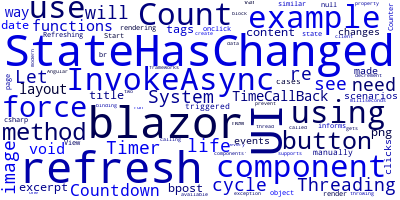Refresh a Blazor Component with StateHasChanged and InvokeAsync

In most scenarios, blazor will refresh UI components when changes are made. for example when events, such as button clicks, are triggered but in some cases you'll need to refresh the UI manually.
Let's see by example how to use StateHasChanged and InvokeAsync to force UI refresh.
Refreshing the UI Using StateHasChanged
You can use the StateHasChanged life-cycle method to force the re-rendering of a blazor component.
This is an example:
@page "/refresh-ui"
@using System.Threading;
@using System.Threading;
Counter: @Count
<br />
<button onclick=@Countdown>Start</button>
@functions {
void Countdown()
{
var timer = new Timer(TimeCallBack, null, 1000, 1000);
}
void TimeCallBack(object state)
{
if (Count > 0)
{
Count--;
InvokeAsync(StateHasChanged);
}
}
}
StateHasChanged() is a method that informs the View that it needs to re-render. It's similar to components' life cycle methods and is only available in the functions{} block.
We create a System.Threading.Timer that will decrement the Count property and run StateHasChanged every 1000 milliseconds to refresh the component. It gets called using InvokeAsync to prevent Blazor throwing an exception when we are calling StateHasChanged from a thread.
Blazor supports one-way and two-way data binding just like modern client frameworks, such Angular.
-
Date:



